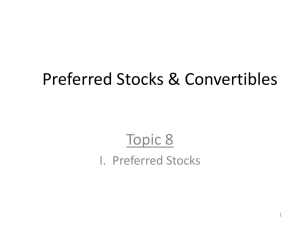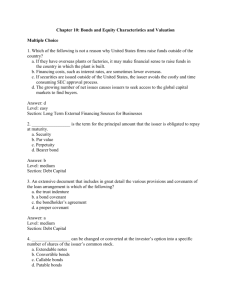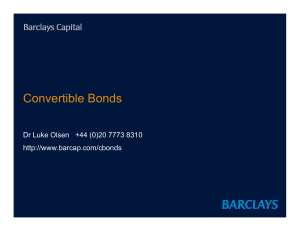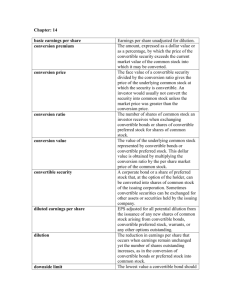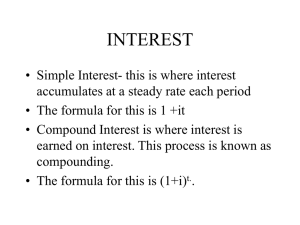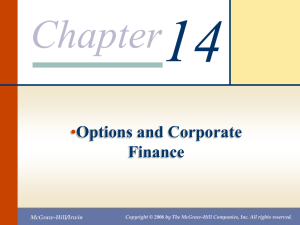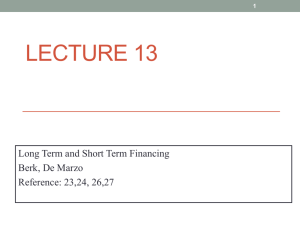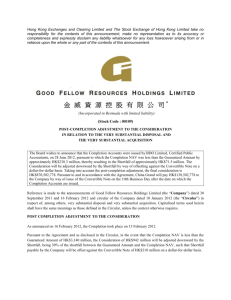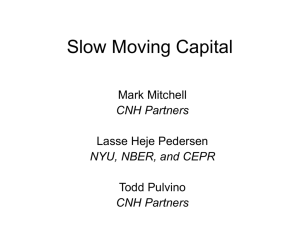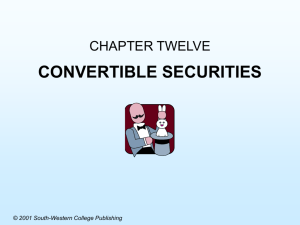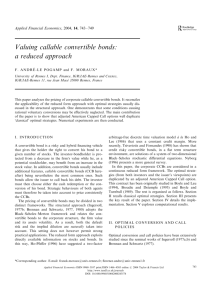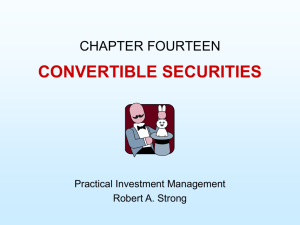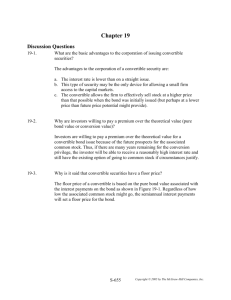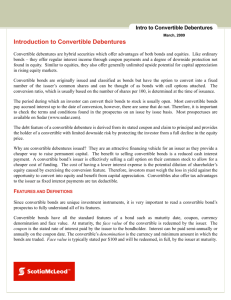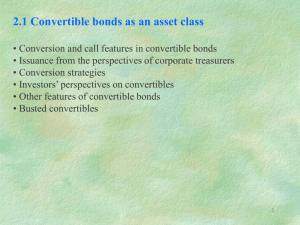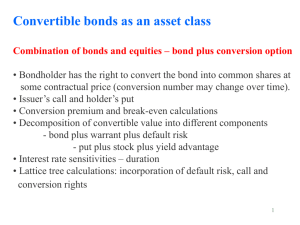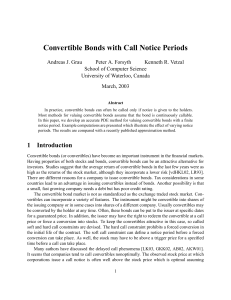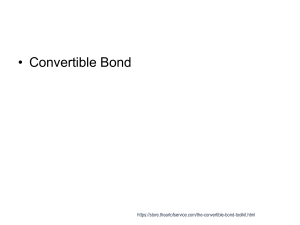OPTIONS
advertisement
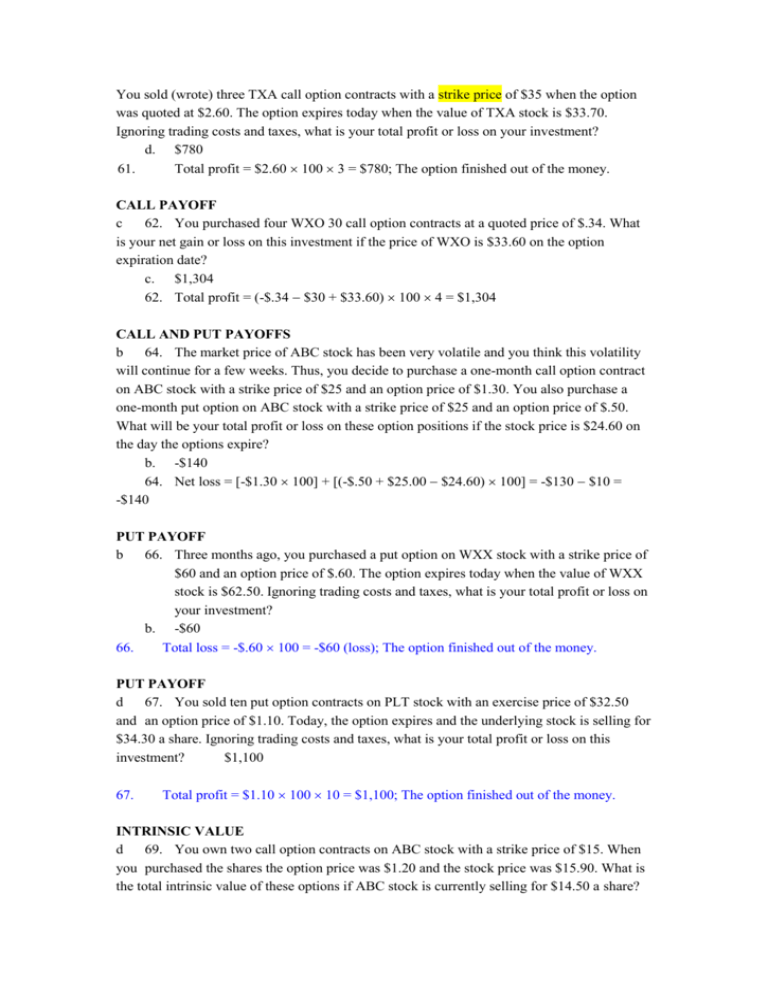
You sold (wrote) three TXA call option contracts with a strike price of $35 when the option was quoted at $2.60. The option expires today when the value of TXA stock is $33.70. Ignoring trading costs and taxes, what is your total profit or loss on your investment? d. $780 61. Total profit = $2.60 100 3 = $780; The option finished out of the money. CALL PAYOFF c 62. You purchased four WXO 30 call option contracts at a quoted price of $.34. What is your net gain or loss on this investment if the price of WXO is $33.60 on the option expiration date? c. $1,304 62. Total profit = (-$.34 $30 + $33.60) 100 4 = $1,304 CALL AND PUT PAYOFFS b 64. The market price of ABC stock has been very volatile and you think this volatility will continue for a few weeks. Thus, you decide to purchase a one-month call option contract on ABC stock with a strike price of $25 and an option price of $1.30. You also purchase a one-month put option on ABC stock with a strike price of $25 and an option price of $.50. What will be your total profit or loss on these option positions if the stock price is $24.60 on the day the options expire? b. -$140 64. Net loss = [-$1.30 100] + [(-$.50 + $25.00 $24.60) 100] = -$130 $10 = -$140 PUT PAYOFF b 66. Three months ago, you purchased a put option on WXX stock with a strike price of $60 and an option price of $.60. The option expires today when the value of WXX stock is $62.50. Ignoring trading costs and taxes, what is your total profit or loss on your investment? b. -$60 66. Total loss = -$.60 100 = -$60 (loss); The option finished out of the money. PUT PAYOFF d 67. You sold ten put option contracts on PLT stock with an exercise price of $32.50 and an option price of $1.10. Today, the option expires and the underlying stock is selling for $34.30 a share. Ignoring trading costs and taxes, what is your total profit or loss on this investment? $1,100 67. Total profit = $1.10 100 10 = $1,100; The option finished out of the money. INTRINSIC VALUE d 69. You own two call option contracts on ABC stock with a strike price of $15. When you purchased the shares the option price was $1.20 and the stock price was $15.90. What is the total intrinsic value of these options if ABC stock is currently selling for $14.50 a share? d. 69. $0 The intrinsic value is zero because the call is currently out of the money. CALL OPTION VALUE e 75. The common stock of Mercury Motors is selling for $43.90 a share. U.S. Treasury bills are currently yielding 4.5 percent. What is the current value of a one-year call option on Mercury Motors stock if the exercise price is $37.50 and you assume the option will finish in the money? e. $8.01 C0 = $43.90 – [$37.50 (1 + .045)] = $8.01 EQUITY AS A CALL OPTION b 80. Martha B’s has total assets of $1,750. These assets are expected to increase in value to either $1,800 or $2,400 by next year. The company has a pure discount bond outstanding with a face value of $2,000.This bond matures in one year. Currently, U.S. Treasury bills are yielding 6 percent. What is the value of the equity in this firm? b. $34.59 80. PVrf = $1,800 (1 + .06) = $1,698.1132; Number of options needed = ($2,400 $1,800) ($400 $0) = 1.5; $1,750 = (1.5 C0) + $1,698.1132; 1.5C0 = $51.8868; C0 = $34.59 OPTION TO WAIT a 82. Wilson’s Antiques is considering a project that has an initial cost today of $10,000. The project has a two-year life with cash inflows of $6,500 a year. Should Wilson’s decide to wait one year to commence this project, the initial cost will increase by 5 percent and the cash inflows will increase to $7,500 a year. What is the value of the option to wait if the applicable discount rate is 10 percent? a. $1,006.76 82. $6,500 $6,500 NPVt 0 $10,000 $10,000 $5,909.0909 $5,371.9008 $1,280.99 1.101 1.102 $7,500 $7,500 NPVt 1 ($10,000 1.05) $10,500 $6,818.1818 $6,198.3471 $2,516.5289 1.101 1.102 NPVt 0 $2,516.5289 1.10 $2,287.75 Value of option to wait = $2,287.75 - $1,280.99 = $1,006.76 OPTION TO ABANDON c 83. Your firm is considering a project with a five-year life and an initial cost of $120,000. The discount rate for the project is 12 percent. The firm expects to sell 2,100 units a year. The cash flow per unit is $20. The firm will have the option to abandon this project after three years at which time they expect they could sell the project for $50,000. At what level of sales should the firm be willing to abandon this project? c. 1,479 units 83. $50,000 (Q $20) CONVERTIBLE BONDS 1 [1 /(1 .12)2 ] ;$50,000 33.801Q; Q 1,479 units .12 d 87. You own six convertible bonds. These bonds have a 5 percent coupon, a $1,000 face value and mature in 8 years. The bonds are convertible into shares of common stock at a conversion price of $20. How many shares of stock will you receive if you convert all of your bonds? d. 300.00 shares 87. Number of shares = $1,000 $20 6 = 300 shares CONVERTIBLE BONDS b 88. A convertible bond has a face value of $1,000 and a conversion price of $22.50. The bond has a 6 percent coupon and pays interest semi-annually. The bond matures in six years. Similar bonds are yielding 7 percent. The current price of the stock is $21.24. What is the conversion value of this bond? b. $944.00 88. Conversion value = $1,000 $22.50 $21.24 = $944.00 OPTIONS a 1. A financial contract that gives its owner the right, but not the obligation, to buy or sell a specified asset at an agreed-upon price on or before a given future date is called a(n) _____ contract. a. option STRIKE PRICE c 3. The fixed price in an option contract at which the owner can buy or sell the underlying asset is called the option’s: c. strike price. EXPIRATION DATE d 4. The last day on which an owner of an option can elect to exercise is the _____ date. d. expiration AMERICAN OPTIONS e 5. An option that may be exercised at any time up its expiration date is called a(n) _____ option. e. American EUROPEAN OPTIONS a 6. An option that may be exercised only on the expiration date is called a(n) _____ option. a. European CALL OPTION b 7. A _____ is a derivative security that gives the owner the right, but not the obligation, to buy an asset at a fixed price for a specified period of time.b. call option PUT OPTION c 8. A _____ is a derivative security that gives the owner the right, but not the obligation, to sell an asset at a fixed price for a specified period of time.c. put option ARBITRAGE d 9. A trading opportunity that offers a riskless profit is called a(n): d. arbitrage. INTRINSIC VALUE e 10. The value of an option if it were to immediately expire, that is, it’s lower pricing bound, is called an option’s _____ value. e. intrinsic WARRANTS b 15. A security that gives the holder the right, but not the obligation, to purchase shares of stock in a firm for a fixed price over a specified period of time is called a(n): b. warrant. CONVERTIBLE BONDS c 16. A bond that can be exchanged for a fixed number of shares of stock in a firm over a specified period of time is called a _____ bond. c. convertible CONVERSION PRICE d 17. The dollar amount of a convertible bond’s par value that is exchangeable for one share of stock is the bond’s: d. conversion price. CONVERSION RATIO e 18. The number of shares of stock received for each convertible bond converted into stock is called the: conversion ratio. CALL UPPER BOUND d 29. The maximum value of a call option is equal to:d. the price of the underlying stock. CALL LOWER BOUND b 30. The lower bound on a call’s value is either the: b. stock price minus the exercise price or zero, whichever is greater. FACTORS AFFECTING OPTION VALUES c 34. Which of the following statements are correct concerning option values? I. The value of a call increases as the price of the underlying stock increases. II. The value of a call decreases as the exercise price increases. c. I and II only FACTORS AFFECTING OPTION VALUES e 35. The value of a call increases when: I. the time to expiration increases. II. the stock price increases. III. the risk-free rate of return increases. IV. the volatility of the price of the underlying stock increases. e. I, II, III, and IV
